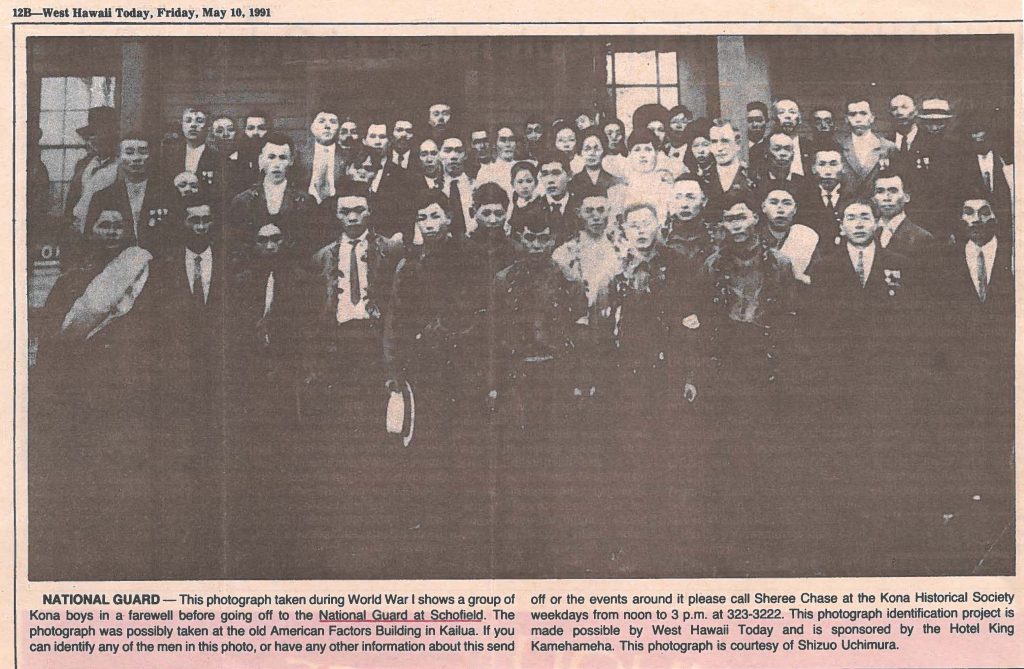1918 Federal Service
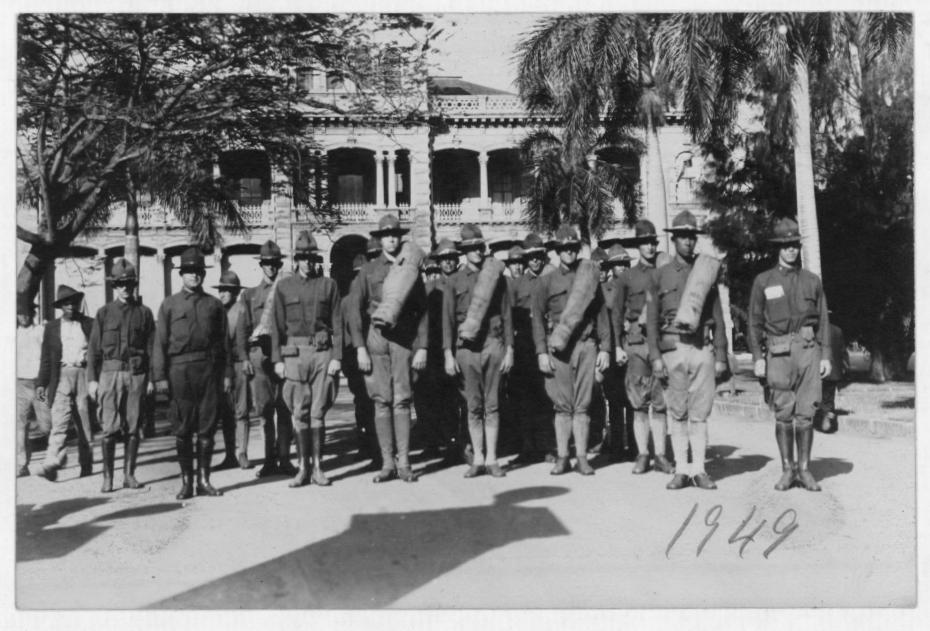
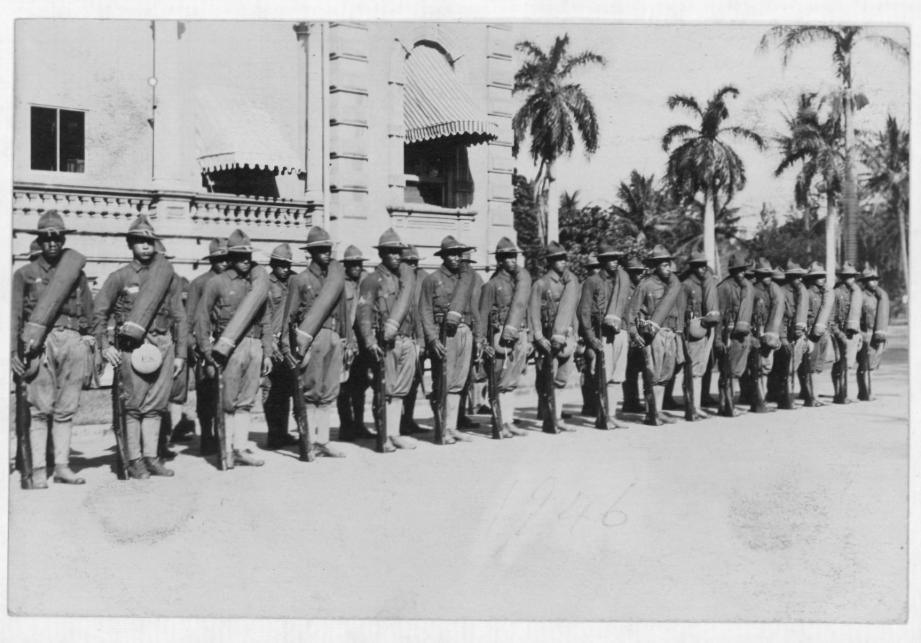



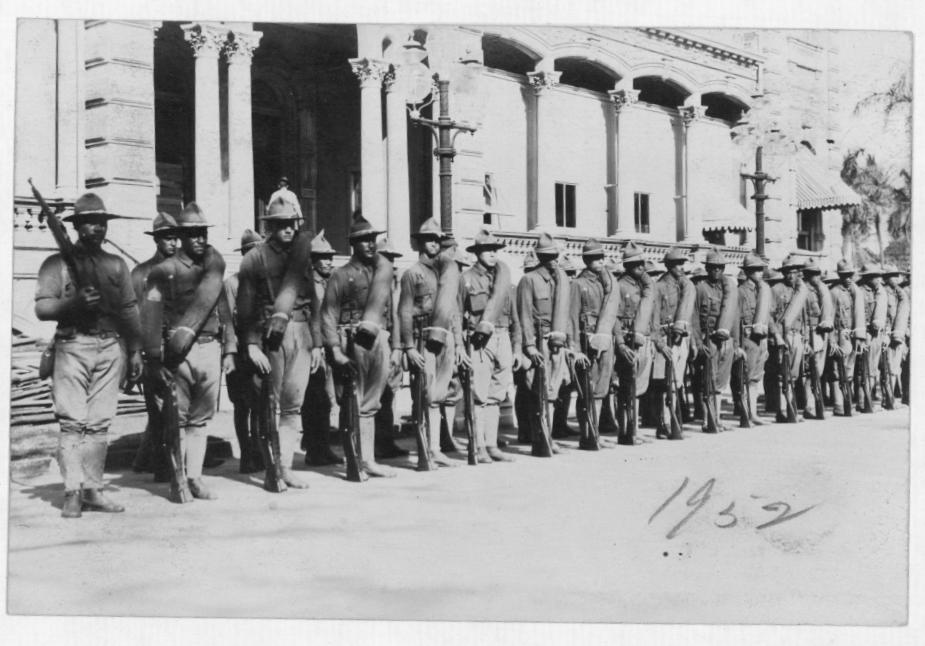


Mobilization for Federal Service
On June 1. 1918, pursuant to instructions from the War Department, the First and Second Regiments of Infantry, and the commissioned and enlisted personnel of the Medical Corps attached, were drafted into Federal service, and the following table shows the number of officers and enlisted men drafted, including Medical Corps:
Officers Enlisted Men Reported Rejected Accepted Reported Rejected Accepted 1st Infantry 52 0 52 1,384 377 1,047 2nd Infantry 53 4 49 1,741 288 1,453 Totals 105 4 101 3,125 665 2,500 The total of officers and enlisted men rejected is 20.07 per cent of the number reporting. This, however, in the case of enlisted men, does not mean that rejections were all given for physical disability, a large proportion of these rejections being clue to other causes.
In the mobilization of the Guard, credit must be given to the Territorial Quartermaster and his corps for the dispatch with which the schedule was prepared and the manner in which it was carried out in the transportation of troops and equipment from stations outside of Honolulu.
Mention must also be made of the excellent co-operation by the management of the Inter-Island Steamship Navigation Company, Ltd., in the carrying out of the schedule of transportation, all of which was accomplished without any accident to life or property.
Officers and Enlisted Men Called Into Federal Service
During 1917 and 1918, prior to the induction of the First and Second Regiments into the Federal Service, there were 25 officers and 102 enlisted men authorized to attend three Reserve Officers’ Training Camps held at Schofield Barracks, Oahu. Of these there were 21 officers and 75 enlisted men discharged from the Guard and accepted in the Military services of the United States. In addition to the above, one officer (General Samuel I. Johnson) was called from the National Guard into Federal service with the rank of Major, and six others with the rank held by them in the Guard at the time they were called. In this connection, it may be said that the showing made and results obtained by the officers and enlisted men at the Reserve Officers’ Training Camps; the number of officers called into Federal service with the rank then held by them, and the fact that nearly all of the officers and non-commissioned officers drafted June 1, 1918, retained their former, and in many cases a higher rank, is cause for gratification and shows to great advantage the result of the military training as conducted in the National Guard. Credit for this success must be given to the untiring zeal of Major Edward F. Witsell, U.S.A., the Senior Inspector-Instructor, who during the short time at his disposal, including the time put in at the annual encampment of 1917, did everything within his power to correct errors and bring the organization to as near a state of efficiency for active duty as possible.
– 1917-1918 Annual Report pp.4-5

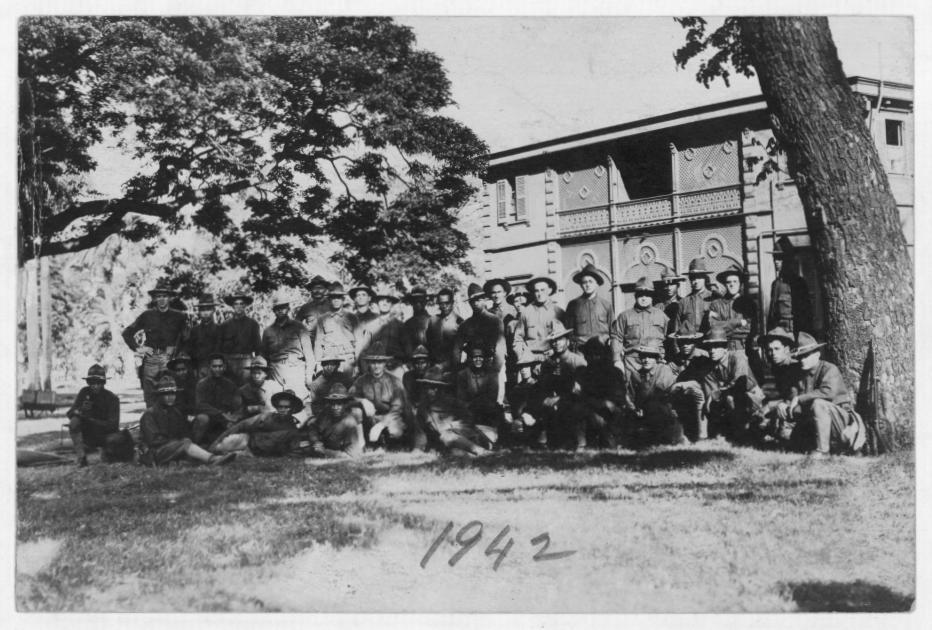
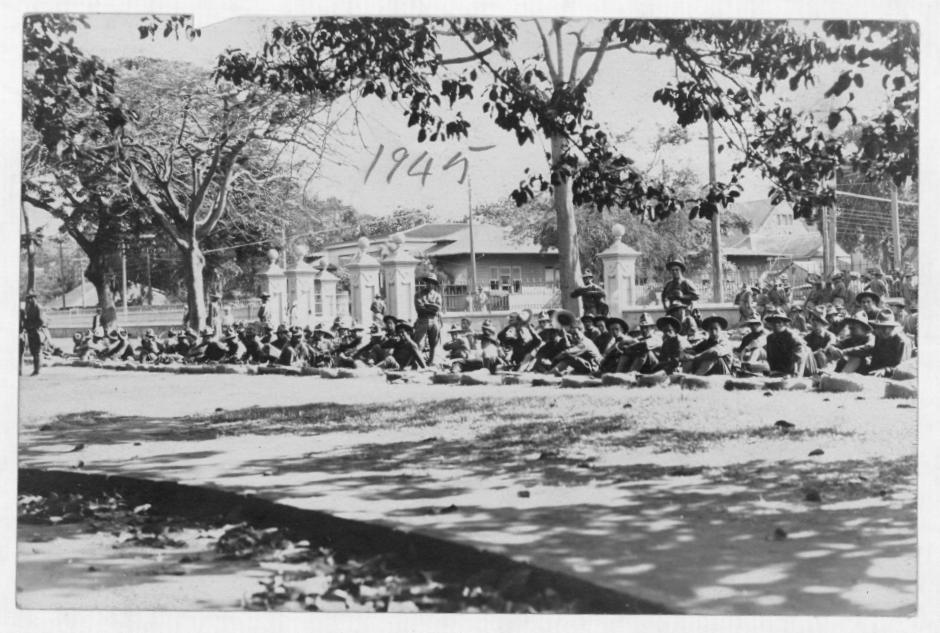

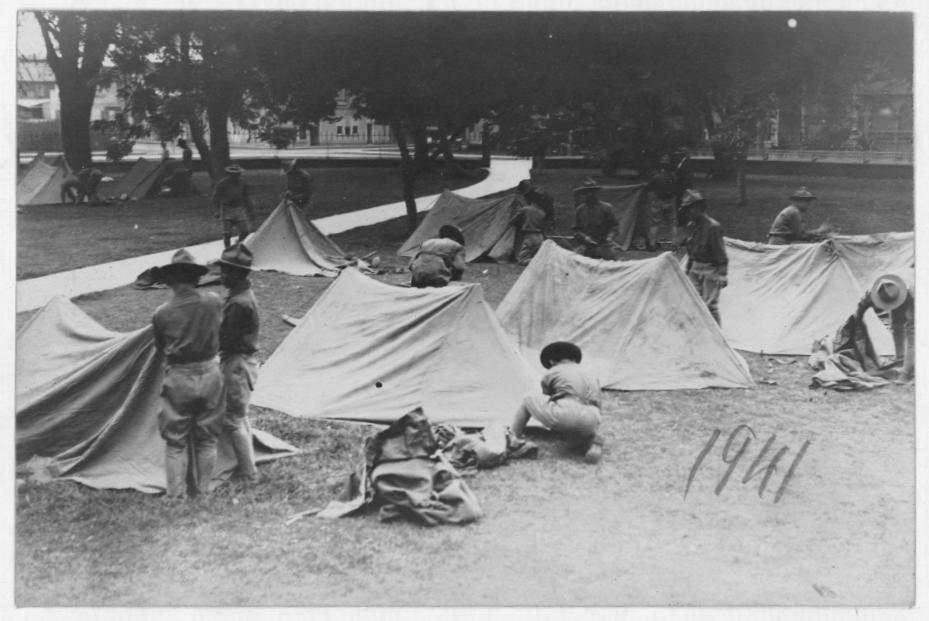
On June 1, 1918, orders were received through the office of the Commanding General of the Hawaiian Department drafting into the service of the United States, on and from that date, the 1st and 2nd Infantries, National Guard of Hawaii, and all members of the Medical Corps, National Guard of Hawaii. Colonel Wayne ordered the 1st Infantry to report to the mobilization camp to be established at Fort Armstrong as soon as possible. The 2nd Infantry was ordered to proceed to Honolulu by the first available transportation. The Engineer and Signal Corps Companies were disbanded and the men transferred to the 1st Infantry so that they might participate in the mobilization.
The establishment of the mobilization camp at Fort Armstrong was commenced on June 1st. Within four days the entire camp had been set up under canvas and mess halls and kitchens installed in several buildings at the Immigration Station. By the time that the men started arriving on June 5th a hospital, a canteen and a Red Cross station were in operation. The officers detailed from the regular army in charge of the camp were Colonel William C. Bennett, Camp Commander; 1st Lieutenant James L. Ballard, Camp Adjutant; Major James D. Dougherty, Quartermaster; Major Charles B. Cooper, Medical Officer; and Captain Edward F. Witsell, Senior Mustering Officer.
On June lst, upon receiving his orders, Colonel W. R. Riley, Commanding Officer of the 1st Infantry, ordered the 1st and 2nd Battalions to report to the Honolulu Armory prepared to establish camp. That afternoon the two battalions established a temporary camp under shelter tents in the Capitol Grounds and named their camp Camp McCarthy. The 3rd Battalion was instructed to go into camp at its home rendezvous and prepare itself for transfer to Honolulu. The four companies from rural Oahu were brought into Honolulu on June 4th and also went into camp at Camp McCarthy. As there were no facilities for feeding the men in Camp McCarthy, arrangements had to be made with local restaurants. The 1st Infantry was at Camp McCarthy only a few days but spent this short time in intensive drilling and conditioning. Arrangements were made with the Inter-Island Steam Navigation Company to transport the 2nd Infantry to Honolulu as soon as the 1st Infantry ‘reported to the mobilization camp.
On the morning of the 5th the 1st Infantry broke camp and marched to the mobilization camp. It quickly established itself in the large pyramidal tents that had been put up and prepared for a physical examination, which the personnel would have to pass before being mustered into the regular army. The U.S. Army Medical Corps had established a dispensary in a series of tents along one side of the camp and formed the men into a long line for examination. The officers were first examined and all passed. Company H, 1st Infantry, was next to be examined and all but twenty-eight were mustered into the regular service.
Company H was immediately sent to Schofield Barracks and placed on active duty. The examination was somewhat retarded by the lack of sufficient doctors, but fortunately little confusion resulted. As soon as the companies were examined they were mustered in and sent out to Schofield Barracks. In the meantime the 2nd Infantry had arrived from the other islands and had established itself at Camp McCarthy. As the companies of the 1st Infantry moved out of the mobilization camp, the companies of the 2nd Infantry moved in so that a steady flow of men was maintained at the camp at all times.
By the middle of June the 1st Infantry finished the examination and had been sent to Schofield Barracks. Out of the 1,384 enlisted men examined, 1,007 had been accepted for federal service. By the 22nd of June the 2nd Infantry had likewise left the mobilization camp. Four of its officers had been refused, but out of 1,741 enlisted men only 288 had been declared unfit for military service. Upon being mustered into federal service the designations of the regiments were changed to the 1st Hawaiian Infantry, U.S. Army, and the 2nd Hawaiian Infantry, U.S. Army.
It had been the intention of the War Department that these two regiments should relieve the regular forces on the Islands and allow them to be transferred to the mainland. During July three regiments of regulars at Schofield Barracks and Fort Shafter were relieved of their command and sent overseas. The 1st and 2nd Regiments immediately took over their garrison duties. One battalion from the 1st Regiment was transferred to Fort Shafter, but the remainder of the National Guard troops remained at Schofield Barracks. In October the two regiments were consolidated into the Hawaiian Brigade under the command of Brigadier General J. W. Herd, U.S.A. They performed the regular garrison duties, stood guard, policed the camps, and also spent a considerable amount of time in drilling and training.
At first the regiments were somewhat below their war-time strength, due to the many rejections for physical disability, but they were soon enlarged by men taken in the Selective Draft. The Selective Draft had been put into operation on the mainland some time earlier, but had not been necessary in Hawaii because the Islands had already contributed more than their share of men by volunteer enlistment. Now, however, the War Department decided to include the Hawaiian Islands in the Selective Draft.
All the men in the Territory between the ages of twenty-one and thirty had been required to register with the government by July 31, 1917. This had been enlarged by October 26, 1917, to include all male residents of the Territory between the ages of nineteen and forty. The total enrollment was about 27,000 on July 31st and about 41,000 on October 26th. These men were given a serial number and required to answer a number of questions and take a physical examination, from which they were classified into five groups according to their military availability.
On July I, 1918, just one month after the National Guard of Hawaii had been mobilized, orders were received in Hawaii for the mobilization of 4,336 registrants to increase the two National Guard regiments up to war time strength. The priority in which these registrants would be called into active service had already been determined by lot, so it was necessary only to inform the men to report for physical examinations. Upon reporting, the men were sent to the mobilization camp at Fort Armstrong. The 2nd Hawaiian Infantry had not left the camp by the time that the first of the draftees began to arrive. However, the latter were sent in small groups so that there were never more than six or seven hundred men in camp at the same time.
The method of handling the draftees was similar to the method used in mobilizing the National Guard. The men were given a physical examination and the unfit rejected. Those accepted were given a short period of training and conditioning and then sent to either the 1st or 2nd Hawaiian Infantry for duty, Up to December 15, 1918, some 4,443 men had been drafted, accepted and assigned to duty. The Selective Draft was discontinued soon after the Armistice and the men returned to civilian life.
As Soon as the Armistice was signed steps were taken to commence the demobilization of the National Guard of Hawaii. All the men were questioned and those who wished to be discharged as soon as possible were transferred to the 2nd Infantry. Demobilization of this regiment was commenced on January 27, 1919, and was completed in about two weeks. The 1st Hawaiian Infantry remained on active duty until July 3, 1919, when it was also returned to civilian life. There was, of course, some difficulty encountered in the process of assimilating these men back into private life, but with the help of several social organizations the task was successfully accomplished.
The 1st and 2nd Regiments, Hawaiian Infantry, had performed very valuable service to their country while on active duty. Their job had not been an easy one, and they were for the most part inexperienced. Had the Armistice not intervened there is no doubt but that they would have become very efficient military organizations. As it was, they did their task splendidly but simply did not have sufficient time to acquire the experience or polish necessary for finished military organizations
– History of the Hawaii National Guard pp. 75-79

Guardsmen encamp at Fort Armstrong
June 1918
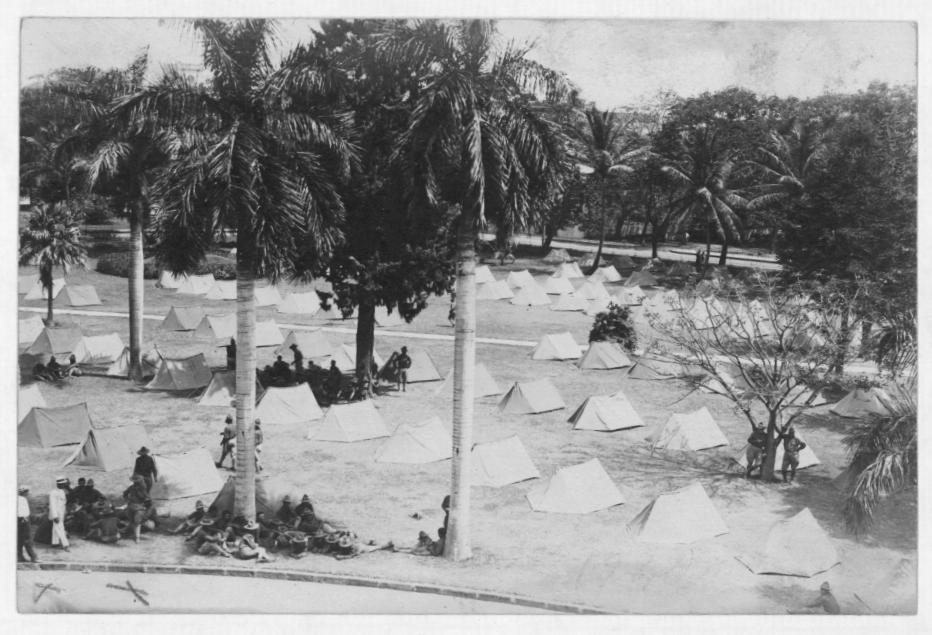
Mobilization of Hawaii Guardsmen
June 1918
Iolani Palace Grounds

Newspaper Articles and Photos
